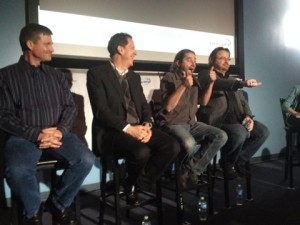 Burbank-based AlphaDogs Post celebrated the 11th Annual Pre-NAB Editors’ Lounge with a panel discussion on the latest trends in postproduction and what to expect at this year’s NAB in Las Vegas. Topics ranged from 4K to cloud-based technologies, and the future of the postproduction professional. Moderated by journalist Debra Kaufman, the event’s panelists included Terence Curren, editor/colorist and founder of AlphaDogs, Mark Raudonis, VP of postproduction – Bunim/Murray Productions, Michael Kammes, director of technology – Key Code Media, and Ramy Katrib, CEO, Digital Film Tree.
Burbank-based AlphaDogs Post celebrated the 11th Annual Pre-NAB Editors’ Lounge with a panel discussion on the latest trends in postproduction and what to expect at this year’s NAB in Las Vegas. Topics ranged from 4K to cloud-based technologies, and the future of the postproduction professional. Moderated by journalist Debra Kaufman, the event’s panelists included Terence Curren, editor/colorist and founder of AlphaDogs, Mark Raudonis, VP of postproduction – Bunim/Murray Productions, Michael Kammes, director of technology – Key Code Media, and Ramy Katrib, CEO, Digital Film Tree.
The evening began with a discussion regarding the changes in the 3D market. While the novelty of 3D television has had its run, it’s expected that 3D will not go away entirely due to China’s heavy investment in the market, as well as other platforms continuing to utilize 3D graphics. It was also agreed that film is dead, but is still the best format for archiving picture images. New storage technologies currently on the market include Sony’s Blu-Ray archival disk and the experimental fused quartz-based storage that scientists from the U.K. and the Netherlands are developing that could store up to 360 terabytes of data. This is equal to 75,000 industry standard DVD’s with potential lifetime data storage of 100 million years. It is expected to be on the market by 2015.
4K UltraHD TV was a hot topic once again this year with Curren using props to demonstrate why consumers won’t be able to see the difference between picture quality in 4K and HD televisions. “The human eye has a limited ability to perceive detail,” said Curren. “You would have to be very close to the screen to see a difference between 4K and 1080p resolution, and how many people sit 5 feet from their 65-inch screen television in their home? What makes more sense are better pixels, not more pixels. HDR or High Dynamic Range with more color and a higher bit depth would be better for the consumer experience.”
Posting and delivery in 4K (or UHD) as opposed to 1080 HD will require four times the bandwidth, storage and processor power in equipment, meaning post facilities would be required to build an entirely new infrastructure in order to deliver content in 4K. Curren explained, “We’re being forced down a path to put a lot of effort and expense into buying all new gear when the consumer at home will not see an appreciable difference. This is about television manufacturers wanting to sell more televisions, and not about a better viewing experience.”
Providing clients with cloud-based postproduction solutions is in higher demand than previous years, but still has limitations due to limited bandwidth and cost. “Besides throughput issues, the storage space in the cloud is still very expensive. Once we have more fiber connected cities, I think you will see this technology move to mainstream,” said Kammes. The future of careers in film and television editing within a cloud-based environment would likely create an extremely competitive marketplace, as editors would then have to compete with a global pool of talent.
Curren added, “The producers and directors are used to working in the room with the editor. If they get used to being in the room without an editor, at that point the editor can be anywhere in the world, and then economics speak louder than anything else. Check out the VFX industry.”
The evening wrapped with the panelists agreeing that NAB is a great networking opportunity to meet people from around the world. Katrib said, “It’s all about the human interactions and meeting people from Asia or Europe that would be hard to meet otherwise.” While NAB no longer seems to pack the punch for any major announcements in gear, it’s still a great way to get educated on the newest technologies available for the postproduction professional. “Although it has become more of a social event, I would strongly encourage attending,” said Raudonis. “It’s the best way to get a snapshot of where the industry is in one week, and you’re good to go for the rest of the year.”






